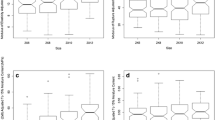Abstract
Visually graded southern pine (SP) has wide variability within grade. For 2 × 4 lumber, this variability has increased because it is harvested from both natural forests and plantation forests where trees contain high percentages of juvenile wood. To investigate resource variability, six kiln-dried No. 2 2 × 4 SP packages were acquired from six mills. From each package, 124 samples were destructively tested in bending. Mean modulus of elasticity (MOE15) ranged from 9.2 to 13.1 GPa, and three mills did not meet the design values (11.0 GPa). Bending strength (F b) ranged from 7.6 to 11.9 MPa, and four mills did not meet the design values (10.3 MPa). Analysis of variance of MOE15 and F b showed significant differences between mills. MOE15 explained from 33 to 51 % of the variability in F b. These data suggest that variation between mills is high and destructive testing is critical for more accurate characterization of lumber properties.



Similar content being viewed by others
References
American Forest & Paper Association (AF&PA) (2005) National design specification (NSD) for wood construction with commentary and supplement: Design values for wood construction 2005 edition
American Lumber Standards Committee (ALSC) (2012) American Standard Committee Board of Review: In the matter of the submission of the Southern Pine Inspection Bureau for Approval of Supplement 9. http://www.alsc.org/greenbook%20collection/ALSC_BOR_Notice_on_design_values.pdf. Accessed Feb 8, 2012
ASTM International (2007) ASTM D1990–07: Standard practice for establishing allowable properties for visually-graded dimension lumber from in-grade tests of full-size specimens. West Conshohocken, PA
ASTM International (2009) ASTM D198–09: Standard test methods of static tests of lumber in structural sizes. West Conshohocken, PA
ASTM International (2010) ASTM D2915–10: Standard practice for evaluating allowable properties for grades of structural lumber. West Conshohocken, PA
Bendtsen BA (1978) Properties of wood from improved and intensively managed trees. Forest Prod J. 28(10):61–72
Borders BE, Bailey RL (2001) Loblolly pine—pushing the limits of growth. South J Appl For 25:69–74
Briggs D (2010) Enhancing forest value productivity through fiber quality. J Forestry 108:174–182
Clark A III, Jordan L, Schimleck L, Daniels RF (2008) Effect of initial planting spacing on wood properties of unthinned loblolly pine at age 21. Forest Prod J 58(10):78–83
Dahlen J, Jones PD, Seale RD, Shmulsky R (2012) Bending strength and stiffness of in-grade Douglas-fir and southern pine No. 2 2 × 4 lumber. Can J For Res 42:858–867
Dunn MA, Shupe TF, Vlosky RP (2003) Homebuilder attitudes and preferences regarding southern yellow pine. Forest Prod J 53(4):36–41
Evans JW, Kretschmann DE, Herian VL, Green DW (2001) Procedures for developing allowable properties for a single species under ASTM D1990 and computer programs useful for the calculations. USDA Forest Service. Forest Products Laboratory. FPL-GTR-126
Forest Products Laboratory (2011) NONPAR: Nonparametric estimation program. http://www1.fpl.fs.fed.us/nonpar.html. Accessed Sept 26, 2011
Glass SV, Zelinka SL (2010) Moisture relations and physical properties of wood. Wood Handbook. USDA Forest Service. Forest Products Laboratory. FPL-GTR-190
Green DW, Evans JW (1988) Mechanical properties of visually graded lumber: Volume 1. A summary. National Technical Information Service. PB-88-159-389
Howard J (2007) U.S. timber production, trade, consumption, and price statistics 1965 to 2005. USDA: Forest Products Laboratory. FPL-RP-637
Jones E (1989) Sampling procedures used in the in-grade lumber testing program. In: Proceedings of workshop sponsored by in-grade testing committee and forest products society. Proceedings 47363. Madison, WI: Forest Products Society
Jordan L, Re R, Hall DB, Clark A III, Daniels RF (2006) Variation in loblolly pine cross-sectional microfibril angle with tree height and physiographic region. Wood Fiber Sci 38(3):390–398
Jordan L, Clark A III, Schimleck LR, Hall DB, Daniels RF (2008) Regional variation in wood specific gravity of planted loblolly pine in the United States. Can J For Res 38:698–710
Kretschmann DE (2010) Mechanical properties of wood. Wood Handbook. USDA Forest Service. Forest Products Laboratory. FPL-GTR-190
Kretschmann DE, Bendtsen BA (1992) Ultimate tensile stress and modulus of elasticity of fast-grown plantation loblolly pine lumber. Wood Fiber Sci 24(2):189–203
Kretschmann DE, Evans JW, Brown L (1999) Monitoring of visually graded structural lumber. USDA Forest Service. Forest Products Laboratory. FPL-RP-576
Larson PR, Kretschmann DE, Clark III A, Isebrands JG (2001) Formation and properties of juvenile wood in southern pines. USDA Forest Service. Forest Products Laboratory. FPL-TR-129
McAlister RH, Clark A III (1991) Effect of geographic location and seed source on the bending properties of juvenile and mature loblolly pine. Forest Prod J 41(9):39–42
National Institute of Standards and Technology (NIST) (2010) Voluntary Product Standard PS 20-10: American Softwood Lumber Standard. U.S. Department of Commerce. National Institute of Standards and Technology
Pearson RG, Gilmore RC (1980) Effect of fast growth rate on the mechanical properties of loblolly pine. Forest Prod J 30(5):47–54
Pillow MY, Terrell BZ, Hiller CH (1953) Patterns of variation in fibril angles of loblolly pine. U.S. Department of Agric., Forest Service, Forest Products Laboratory. Report No. D1935
Southern Forest Products Association (SFPA) (2009) Annual Report. [White paper]
USDA Forest Service (1988) The South’s fourth forest; alternative for the future. USDA Forest Service, Forest Resource Report 24. U.S. Government Print. Office. Washington, DC
Wear DN, Greis JG (2002) The southern forest resource assessment - summary report. Gen. Tech. Rep. SRS-54. Asheville, NC: U.S. Department of Agriculture, Forest Service, Southern Research Station and Southern Region
Zobel B (1984) The changing quality of the world wood supply. Wood Sci Technol 18:1–17
Conflict of interest
The authors declare they have no conflict of interest.
Author information
Authors and Affiliations
Corresponding author
Rights and permissions
About this article
Cite this article
Dahlen, J., Jones, P.D., Seale, R.D. et al. Mill variation in bending strength and stiffness of in-grade southern pine No. 2 2 × 4 lumber. Wood Sci Technol 47, 1153–1165 (2013). https://doi.org/10.1007/s00226-013-0564-5
Received:
Published:
Issue Date:
DOI: https://doi.org/10.1007/s00226-013-0564-5




